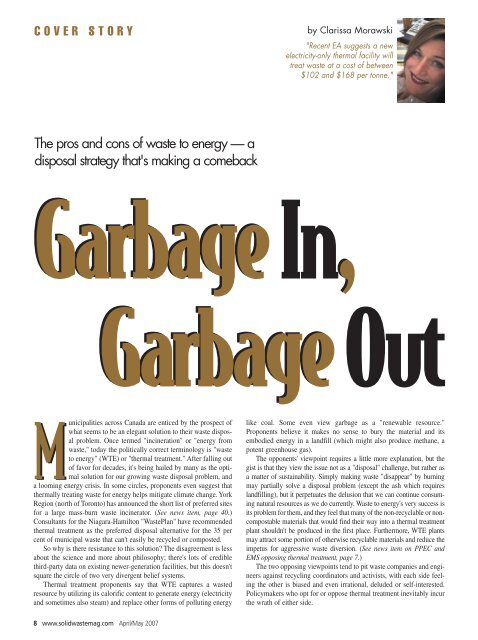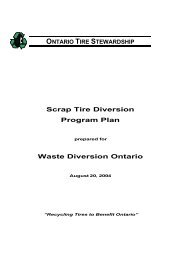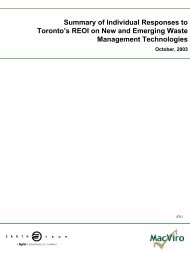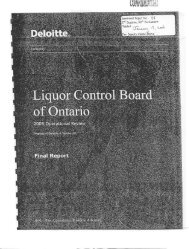swr apr-may 07 pgs 8-13 - Solid Waste and Recycling
swr apr-may 07 pgs 8-13 - Solid Waste and Recycling
swr apr-may 07 pgs 8-13 - Solid Waste and Recycling
Create successful ePaper yourself
Turn your PDF publications into a flip-book with our unique Google optimized e-Paper software.
<strong>swr</strong> <strong>apr</strong>-<strong>may</strong> 20<strong>07</strong> Cvr sty <strong>pgs</strong> 8-<strong>13</strong> 4/26/<strong>07</strong> 11:36 AM Page 8<br />
COVER STORY<br />
by Clarissa Morawski<br />
"Recent EA suggests a new<br />
electricity-only thermal facility will<br />
treat waste at a cost of between<br />
$102 <strong>and</strong> $168 per tonne."<br />
The pros <strong>and</strong> cons of waste to energy — a<br />
disposal strategy that's making a comeback<br />
Garbage In,<br />
Garbage Out<br />
Municipalities<br />
M<br />
across Canada are enticed by the prospect of<br />
what seems to be an elegant solution to their waste disposal<br />
problem. Once termed "incineration" or "energy from<br />
waste," today the politically correct terminology is "waste<br />
to energy" (WTE) or "thermal treatment." After falling out<br />
of favor for decades, it's being hailed by many as the optimal<br />
solution for our growing waste disposal problem, <strong>and</strong><br />
a looming energy crisis. In some circles, proponents even suggest that<br />
thermally treating waste for energy helps mitigate climate change. York<br />
Region (north of Toronto) has announced the short list of preferred sites<br />
for a large mass-burn waste incinerator. (See news item, page 40.)<br />
Consultants for the Niagara-Hamilton "<strong>Waste</strong>Plan" have recommended<br />
thermal treatment as the preferred disposal alternative for the 35 per<br />
cent of municipal waste that can't easily be recycled or composted.<br />
So why is there resistance to this solution? The disagreement is less<br />
about the science <strong>and</strong> more about philosophy; there's lots of credible<br />
third-party data on existing newer-generation facilities, but this doesn't<br />
square the circle of two very divergent belief systems.<br />
Thermal treatment proponents say that WTE captures a wasted<br />
resource by utilizing its calorific content to generate energy (electricity<br />
<strong>and</strong> sometimes also steam) <strong>and</strong> replace other forms of polluting energy<br />
like coal. Some even view garbage as a "renewable resource."<br />
Proponents believe it makes no sense to bury the material <strong>and</strong> its<br />
embodied energy in a l<strong>and</strong>fill (which might also produce methane, a<br />
potent greenhouse gas).<br />
The opponents' viewpoint requires a little more explanation, but the<br />
gist is that they view the issue not as a "disposal" challenge, but rather as<br />
a matter of sustainability. Simply making waste "disappear" by burning<br />
<strong>may</strong> partially solve a disposal problem (except the ash which requires<br />
l<strong>and</strong>filling), but it perpetuates the delusion that we can continue consuming<br />
natural resources as we do currently. <strong>Waste</strong> to energy's very success is<br />
its problem for them, <strong>and</strong> they feel that many of the non-recyclable or noncompostable<br />
materials that would find their way into a thermal treatment<br />
plant shouldn't be produced in the first place. Furthermore, WTE plants<br />
<strong>may</strong> attract some portion of otherwise recyclable materials <strong>and</strong> reduce the<br />
impetus for aggressive waste diversion. (See news item on PPEC <strong>and</strong><br />
EMS opposing thermal treatment, page 7.)<br />
The two opposing viewpoints tend to pit waste companies <strong>and</strong> engineers<br />
against recycling coordinators <strong>and</strong> activists, with each side feeling<br />
the other is biased <strong>and</strong> even irrational, deluded or self-interested.<br />
Policymakers who opt for or oppose thermal treatment inevitably incur<br />
the wrath of either side.<br />
8 www.solidwastemag.com April/May 20<strong>07</strong>
<strong>swr</strong> <strong>apr</strong>-<strong>may</strong> 20<strong>07</strong> Cvr sty <strong>pgs</strong> 8-<strong>13</strong> 4/26/<strong>07</strong> 11:36 AM Page 9<br />
COVER STORY<br />
Material Energy Energy output Energy<br />
savings from from Thermal savings from<br />
<strong>Recycling</strong> treatment recycling<br />
(GJ) tonne (GJ) tonne versus<br />
thermal<br />
treatment<br />
Newsprint (6.33) (2.62) 2.4<br />
Fine Paper (15.87) (2.23) 7.1<br />
Cardboard (8.56) (2.31) 3.7<br />
Other Paper (9.49) (2.25) 4.2<br />
HDPE (64.27) (6.30) 10.2<br />
PET (85.16) (3.22) 26.4<br />
Other Plastic (52.09) (4.76) 10.9<br />
Source: Determination of the Impact of <strong>Waste</strong> Management Activities on Greenhouse Gas Emissions: 2005 Update<br />
Final Report, ICF Consulting October 31, 2005, submitted to Environment Canada <strong>and</strong> Natural Resources Canada<br />
The macro perspective<br />
Long term trends <strong>may</strong> work against thermal treatment in Canada,<br />
despite its current level of public support (80 per cent in some polls).<br />
The public is becoming highly aware of the threat of man-made climate<br />
change <strong>and</strong> other sustainability challenges. People are hungry for any<br />
opportunity to mitigate global warming <strong>and</strong> the other side-effects of the<br />
consumer society that are placing whole ecosystems under stress <strong>and</strong>,<br />
ultimately, in danger of collapse.<br />
It's established that recycling waste results in a significant energy<br />
savings as the need to extract primary resources is avoided. The energy<br />
gained from thermally treating that waste instead of recycling it is but<br />
a fraction of the benefit. (See charts above <strong>and</strong> on page 11.) Maximizing<br />
recycling is not simply about saving l<strong>and</strong>fill space; it's about<br />
improved energy efficiency <strong>and</strong> reduced greenhouse gases.<br />
Proponents argue that high recycling <strong>and</strong> thermal treatment are<br />
compatible, but as recycling success moves beyond 60 per cent it will<br />
impact the fuel (waste) used in a thermal facility. Increased source separation<br />
in the IC&I <strong>and</strong> construction <strong>and</strong> demolition sectors <strong>and</strong> multiresidential<br />
dwellings, including organic waste, will all contribute to<br />
achieving greater than 60 per cent diversion. If this happens (which<br />
many believe is inevitable) the waste stream won't have a high calorific<br />
value.<br />
This is not ideology; it's supported by research on the technical <strong>and</strong><br />
environmental parameters for waste to energy <strong>and</strong> recycling of household<br />
waste published in the International Journal of Thermal Science<br />
(Volume 43 [2004] 519-529), which states that increased recycling<br />
"leads to a decrease of energy recovery so that it is necessary to use<br />
additional boilers to meet the initial energy dem<strong>and</strong>. The related<br />
impacts tend to offset the environmental benefits derived by the waste<br />
recycling itself." It continues, "The main drawback of the selective collection<br />
of household waste is that it involves a decrease of the energy<br />
produced by waste incineration mainly caused by the recovery of<br />
paper/cardboard <strong>and</strong> plastics."<br />
There is certainly some fraction of the waste stream that cannot be<br />
recycled or composted economically (the bloody meat wrapper being a<br />
popular example), so some kind of disposal will always be necessary<br />
until we achieve "zero waste," but before we get to that, some other factors<br />
need to be understood.<br />
"Expansions at Greenlane, Walker <strong>and</strong><br />
Warwick l<strong>and</strong>fills have created about<br />
50 million new tonnes of l<strong>and</strong>fill<br />
capacity in Ontario."<br />
April/May 20<strong>07</strong> www.solidwastemag.com 9
<strong>swr</strong> <strong>apr</strong>-<strong>may</strong> 20<strong>07</strong> Cvr sty <strong>pgs</strong> 8-<strong>13</strong> 4/26/<strong>07</strong> 11:36 AM Page 10<br />
COVER STORY<br />
The carbon market, emissions <strong>and</strong><br />
economics<br />
The global movement to mitigate climate<br />
change will soon see the emergence of national<br />
<strong>and</strong> international policies like carbon taxes,<br />
emissions trading, etc. all of which will further<br />
increase the costs associated with carbon<br />
emitting activities. In the case of electricity<br />
derived from combustion (massburn) <strong>and</strong> gasification<br />
of household waste, the CO 2 emissions<br />
on a Kwh basis are more than 30 per<br />
cent, <strong>and</strong> 90 per cent higher than coal respectively;<br />
<strong>and</strong> 56 per cent <strong>and</strong> 99 per cent higher<br />
than steam turbine natural gas respectively.<br />
(See bar charts.) Aggressive emissions reduction<br />
policy in Canada, like the recently<br />
announced federal Liberal plan (which suggests<br />
a 36 per cent reduction for electricity<br />
generators) will make procurement of waste to<br />
energy much less attractive than it <strong>may</strong> be<br />
today. Instead, energy customers will turn to<br />
hydro, wind, biomass <strong>and</strong> other more "climate<br />
friendly" sources (even nuclear).<br />
It's argued that today's technology is far<br />
less polluting due to more sophisticated pollution<br />
mitigation equipment (which is true).<br />
However, as a society we accept less pollution<br />
than we did decades ago. Consider for example,<br />
dioxins. Dioxins are persistent <strong>and</strong> bioaccumulative<br />
<strong>and</strong> are implicated in cardiovascular<br />
disease, diabetes, cancer <strong>and</strong> a host of other<br />
conditions that include neurobehavioral <strong>and</strong><br />
reproductive effects. So dangerous are these<br />
toxins that in 2001 Canada was the first nation<br />
of 128 to sign on to the Stockholm Convention<br />
on Persistent Organic Pollutants (POPs), an<br />
international treaty designed to end the production<br />
<strong>and</strong> use of some of the world's most<br />
poisonous chemicals. Around the same time,<br />
the Canadian Council of Ministers of the<br />
Environment (CCME) released Canada-Wide<br />
St<strong>and</strong>ards for Dioxins <strong>and</strong> Furans, which<br />
called for virtual elimination under the<br />
Canadian Environmental Protection Act<br />
(CEPA). It's widely accepted that thermal<br />
treatment of municipal solid waste (more<br />
specifically, the combustion of plastics such as<br />
vinyl) releases less dioxin than in the past, but<br />
dioxin has certainly not been eliminated from<br />
the process. In fact, according to the US EPA,<br />
gasification — a newer thermal treatment<br />
technology — actually releases more dioxin<br />
per tonne than traditional mass burn facilities<br />
(<strong>and</strong> treats the waste at a much higher cost).<br />
10 www.solidwastemag.com April/May 20<strong>07</strong>
<strong>swr</strong> <strong>apr</strong>-<strong>may</strong> 20<strong>07</strong> Cvr sty <strong>pgs</strong> 8-<strong>13</strong> 4/26/<strong>07</strong> 11:36 AM Page 11<br />
COVER STORY<br />
Another example is heavy metals like mercury.<br />
Exposure to mercury can lead to developmental<br />
delays, slurred speech, memory loss,<br />
difficulty walking, blindness, paralysis, heart<br />
disease, kidney failure, liver damage <strong>and</strong> even<br />
death at extreme concentrations. The United<br />
Nations estimates that more than one million<br />
children worldwide have brain development<br />
problems as a result of mercury poisoning.<br />
Emission estimates from thermal treatment<br />
equipment manufacturers themselves show<br />
that mercury released from burning municipal<br />
solid waste is about five times higher per Kwh<br />
of electricity than coal, <strong>and</strong> 35 times higher<br />
than steam turbine natural gas. Gasification of<br />
household waste releases 3.8 times more mercury<br />
per Kwh than coal <strong>and</strong> 27 times more<br />
than steam turbine natural gas. Dioxin <strong>and</strong><br />
Source: Energy savings from recycling; Source: Comparative LCAs for Curbside <strong>Recycling</strong><br />
Versus Either L<strong>and</strong>filling or Incineration with Energy Recovery, Morris, Jeff, Sound Resource<br />
Management. Thermal Treatment Output: CEWEP Energy Report (Status 2001-2004)<br />
Results of Specific Data for Energy, Efficiency Rates <strong>and</strong> Coefficients, Plant Efficiency<br />
factors <strong>and</strong> NCV of 97 European W-t-E Plants <strong>and</strong> Determination of the Main Energy<br />
Results CEWEP: Confederation of European <strong>Waste</strong>-to-Energy Plants.<br />
April/May 20<strong>07</strong> www.solidwastemag.com 11
<strong>swr</strong> <strong>apr</strong>-<strong>may</strong> 20<strong>07</strong> Cvr sty <strong>pgs</strong> 8-<strong>13</strong> 4/26/<strong>07</strong> 11:36 AM Page 12<br />
COVER STORY<br />
Data sources: Coal: Ontario MOE — OnAIR Annual Report 2002; Natural Gas: US EPA<br />
— Fifth edition Compilation of Air Emission Factors Volume 1: Mass-burn <strong>and</strong> gasification<br />
thermal technologies data from Niagara Region/City of Hamilton’s EA — <strong>Waste</strong>plan —<br />
Appendix C — Air Emissions from Thermal Technologies.<br />
mercury are but two examples of the hundreds<br />
of toxic emissions from these plants.<br />
Proponents of thermal treatment often use<br />
Western European countries as examples of<br />
success, i.e., lower emission profiles.<br />
However, these countries are also leaders<br />
when it comes to prohibiting toxins in products<br />
(which will eventually become waste).<br />
They also have producer responsibility laws to<br />
ensure that certain products are pulled out of<br />
the waste stream. Canada has only limited regulations<br />
in place to ensure that toxic substances<br />
like mercury are prohibited in products.<br />
While some provinces do recover <strong>and</strong><br />
properly manage end-of-life electronics, special<br />
wastes, etc. our largest provinces like<br />
Ontario <strong>and</strong> Quebec are still far away from<br />
being able to assure citizens that the waste<br />
stream is relatively free of toxins.<br />
And finally — even if you dispute the health<br />
risks from thermal treatment plants — an<br />
important issue to ratepayers is that incineration<br />
12 www.solidwastemag.com April/May 20<strong>07</strong>
<strong>swr</strong> <strong>apr</strong>-<strong>may</strong> 20<strong>07</strong> Cvr sty <strong>pgs</strong> 8-<strong>13</strong> 4/26/<strong>07</strong> 11:37 AM Page <strong>13</strong><br />
COVER STORY<br />
is extremely expensive <strong>and</strong> relies heavily on<br />
electricity sales revenue (not guaranteed) to offset<br />
the high capital <strong>and</strong> operating costs.<br />
Expensive but necessary pollution abatement<br />
equipment, daily operations, natural gas imports<br />
to support the process, l<strong>and</strong>filling costs for the<br />
residual ash, <strong>and</strong> hazardous fly ash all contribute<br />
to the big bill associated with thermal treatment.<br />
Underst<strong>and</strong>ably, costs can vary dramatically<br />
depending on capacity <strong>and</strong> technology, but<br />
recent estimates from the EA undertaken for<br />
Region of Niagara <strong>and</strong> City of Hamilton suggest<br />
that a new electricity-only thermal treatment<br />
facility will cost between $102 <strong>and</strong> $168 per<br />
tonne, with electricity revenues accounting for<br />
about 35 per cent of the annual cost off-set.<br />
Traditional l<strong>and</strong>filling with gas recovery ranges<br />
from $61 to $89 per tonne, <strong>and</strong> mechanical <strong>and</strong><br />
biological treatment with l<strong>and</strong>filling of stabilized<br />
residuals will run between $127 <strong>and</strong> $180<br />
per tonne. Recent government approvals for<br />
expansions at Greenlane, Walker <strong>and</strong> Warwick<br />
l<strong>and</strong>fills have created about 50 million new<br />
tonnes of l<strong>and</strong>fill capacity in Ontario, which<br />
begs the question: Is thermal treatment even<br />
cost competitive?<br />
If we already possess the technology <strong>and</strong><br />
know how to actively work towards minimal<br />
or even zero waste in the future, why would<br />
we invest large sums of money in a potentially<br />
dangerous technology for small amounts of<br />
electricity (usually only enough to power a little<br />
over two thous<strong>and</strong> homes), <strong>and</strong> a technology<br />
which only encourages our current pattern<br />
of unsustainable resource consumption <strong>and</strong><br />
waste generation?<br />
Some countries (e.g., Germany) are now<br />
using "stabilized" l<strong>and</strong>fills, where recyclables,<br />
organics <strong>and</strong> specials wastes are pulled out<br />
<strong>and</strong> only inert, stable waste is l<strong>and</strong>filled (for a<br />
much reduced pollution profile). In contrast to<br />
thermal facilities that require waste input<br />
around the clock, stabilized l<strong>and</strong>fills don't<br />
require such feeding to operate, <strong>and</strong> this supports<br />
maximum diversion. Ideally, segregation<br />
of certain wastes in such l<strong>and</strong>fills could allow<br />
materials mining in future. (For more on stabilized<br />
l<strong>and</strong>fills, see the article on page 16.)<br />
Policymakers <strong>and</strong> citizens need to closely<br />
compare the costs <strong>and</strong> benefits of thermal<br />
treatment with those of MBT <strong>and</strong> stabilized<br />
l<strong>and</strong>fill before they invest in a disposal strategy<br />
for their post-diversion wastes. This is the<br />
debate that needs to unfold publicly now in<br />
Canada before any large waste-to-energy<br />
plants are built.<br />
(Note: Readers are directed to the articles on<br />
gasification <strong>and</strong> stabilized l<strong>and</strong>fill that appear<br />
on pages 14 <strong>and</strong> 16 respectively. Also, the<br />
June/July edition will feature the first of a<br />
series on mechanical <strong>and</strong> biological treatment<br />
[MBT] of waste.)<br />
Clarissa Morawski is principal of CM<br />
Consulting in Peterborough, Ontario.<br />
Contact Clarissa at morawski@ca.inter.net<br />
April/May 20<strong>07</strong> www.solidwastemag.com <strong>13</strong>









